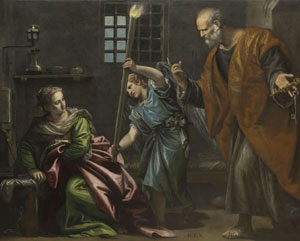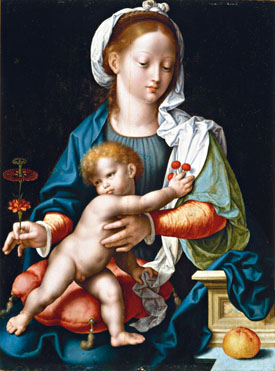Renaissance Piety and Profits
John Haberin New York City
Relative Values and Veronese in Murano
What is that art really worth? With "Relative Values," the Met wants to know.
It could almost be speaking of a painting that has caused no end of arguments and made headlines. Sure, $450 million does sound a little high, even if you believe in the attribution to Leonardo da Vinci, but consider. Whoever purchased Salvator Mundi at auction in 2017 was not just buying a sorely damaged canvas. He was paying for the artist's reputation and virtuosity, even if neither is all that evident in the painting. He was paying for its technological advances, in the High Renaissance turn from tempera to layered oils,  and costly materials, in the pigments that lend the robe a steely blue. He was paying, too, for a culture's belief in the work of art as a kind of magic.
and costly materials, in the pigments that lend the robe a steely blue. He was paying, too, for a culture's belief in the work of art as a kind of magic.
If the Met is any judge, someone in Leonardo's time might have done much the same. It shifts the scene to the Northern Renaissance some years later, but it is still asking about the price of art. It is also finding much the same answers. A small show tries to put a number on anything from tankards and jewelry to painting and sculpture, almost all from the museum's collection. Does it know the price of everything but the value of nothing? One could say the same about the art world today.
Speaking of precious objects, Paolo Veronese did not go to Murano for the glassware. His colors have the intensity and translucency of blown glass, the kind for which Murano is known to this day. They made him famous in his lifetime. But no, they occur most of all on fabric lit seemingly by lightning, much like the robes of his Saints Jerome and Agatha—both in a small chapel in Murano, both newly restored, and both on loan to the Frick. Veronese was himself a snappy dresser, and his paintings depict a life where abundance rules. Yet the saints have a sobriety and even fierceness that belie to the pageantry.
Is art worth it?
Was that shadowy buyer at the auction house, perhaps a Saudi prince on behalf of the Louvre Abu Dhabi, paying not just for art, but for his own enhanced status and self-image? The Met would understand that as well. It looks back to an age that built palaces and churches as a matter of ducal or religious pride. Yet it focuses still more on private markets, admiring art and willing to pay the price. The show unfolds at the entrance to the Lehman collection, where a donor's cash got him his own museum wing and an incursion on Central Park. Could a branch of the Louvre in the desert be far behind?
For all that, the factors that I have mentioned played out quite differently in the Renaissance. For one thing, magic used to mean more than the aura of the work of art. It meant objects of devotion as at once depictions and promises of Christian miracles. It meant materials for their own sake, like alabaster and gilded silver, more than for their optical properties. For another, the calculations back then did not favor fine art. A tapestry could cost ten times as much as a painting—and a drinking vessel a hundred times as much.
To confuse matters, markets were just then emerging. A painting from the workshop of Quentin Massys may have hung in a shop window, but not a fancy gallery. So, too, were local currencies apart from precious metals and what they bought (what an economist might call exchange value and purchasing power). The Met sets its prices in cows, which in turn could trade for well over a thousand loaves of bread. Imagine picking up three or four engravings by Albrecht Dürer in exchange for a single cow—and then herding more than two hundred cattle in exchange for a fancy tankard, inlaid with gold and gems. Imagine herding enough cows to Manhattan to purchase a controversial Leonardo.
It can be off-putting to see only cost, just as today, but buyers did so then as well. The craft that shaped another vessel into a pearly nautilus mattered less than all the gold and gems. The tapestry incorporates silver into its weave.  The Met notes the superiority of bronze to brass and of tin plating to plain glass, but not the poignancy of a sculpted Pietà from decades after Michelangelo. It leaves you to ask what an enthroned Madonna and child were grasping to their right. Yet that excited gesture animates the sculpture as much as the artist's materials or skill.
The Met notes the superiority of bronze to brass and of tin plating to plain glass, but not the poignancy of a sculpted Pietà from decades after Michelangelo. It leaves you to ask what an enthroned Madonna and child were grasping to their right. Yet that excited gesture animates the sculpture as much as the artist's materials or skill.
It leaves it to you, too, to wonder at other advances beyond markets, in the state of the art. Even a lesser artist like the follower of Massys shares in the advance. In accord with Mannerism but also a greater realism, the painting has a startling leap from the foreground to the crags, village, and farmhouse in the distance. The Madonna and child rest on the flight into Egypt by indulging in grapes and a flirtatious smile—much as in a painting from the same time and circle by Joos van Cleve, shown here. Joseph is nowhere to be seen, unless he is the sole tiny background figure. Mary is flirting instead with you.
The Met does not care to ask, but then it can ask only so much. It does not compare the costs of different paintings, as the reputation of someone like Leonardo da Vinci soared at the expense of others. It does not compare the price of objects to their cost to the maker, so it cannot ask either about profits, as workshops gave way to schools and patronage to markets. It never once contrasts judgments of cost then and today. Still, the questions hang in the air, so that counting cows is not just a laughing matter. You must decide for yourself who, after the auction, will have the last laugh.
Painting, fabric, and blown glass
In truth, no one knows for sure what induced Paolo Veronese to the relative backwater of an island just north of late Renaissance Venice. A rough contemporary of Tintoretto or El Greco, he could count himself a rival of an older master in Titian as well, and he aimed big. In his ceiling paintings or a monumental Mystic Marriage of Saint Catherine, figures soar into or stampede down from golden skies. In his Marriage at Cana or the forty-two feet of his Feast in the House of Levi, the many revelers dare anyone to pick out the protagonists or the subject. Needless to say, they are all very well dressed.
He was also perhaps the first ever to plead artistic license—unless one counts Michelangelo's refusal to stick to the initial scheme for the Sistine Chapel. Until Veronese renamed it, that feast barely escaped censure in 1475 as The Last Supper for the indignity of its "buffoons, drunkards, dwarfs, and Germans." In his defense, he spoke of "the same license that poets and jesters take." Today, after centuries dedicated to realism and "serious" art, his indignity sounds downright modern. But does it describe his art?
Veronese worked in Murano nearly ten years before the incident, but he could already be showing off his piety and seriousness of purpose. Where the vaster canvases throw anything and everything at the wall to see what sticks, the saints also show his ability to focus. Jerome holds the center of his painting, despite an equal part above for sky, the eye drawn by the sparkling red of his cloak. Trees frame him like a halo and then some, as dawn breaks behind. His elbow nestles into the space above the skull and the translation of the Bible that kept him busy, as if resting on them, while his rude shelter picks up the Crucifix that appears to him in a vision. One might be seeing Jerome constructing a way of life in the wilderness piece by piece—or Veronese constructing a painting.
Heaven forbid that one should call it a desert, as in older accounts of Jerome alone with his books and his god—not with leaves defining the picture plane or the background of clouds, cliffs, branches, and gentle sunlight. The lion that became Jerome's companion looks more like a pet dog than a wild animal. Agatha appears at home even in prison, and everything pulls the painting toward her, in defiance of Renaissance symmetry. Saint Peter strides in behind an angel bearing a torch like a weapon. Here, too, color shows where and how to look. Peter wears the red of an authority figure, the angel a celestial blue, and Agatha the varied colors of this world.
She also has blood on her shawl, for her Roman tormenters have cut off her breasts, and Peter has healed them. Not that one would know, for she is clothed. Is Veronese too above lechery to show more, or is he too wrapped up in this world for miracles? Peter bears the keys to the kingdom of heaven, but Agatha may care more about the keys to her cell. A shelf above holds bread and wine—the subject of the sacrament, but also the food that her captors have refused her. The shelf also holds a lamp, as earthly illumination in competition to the angel's, and the sky glows through the barred window.
It is a fierce world all the same, and Veronese displays fierce emotions. Jerome holds a stone in one hand, as prelude to self-flagellation, but he could almost be preparing to fling it at Jesus on the cross. His naked torso shows his rib cage, but it could easily pass for musculature. Peter points to heaven, but his gesture and grim expression could just as well be upbraiding Agatha. Not that she cares, with a calm that anchors the whole. She kept her chastity and died peaceably in prison.

"Relative Values" ran at The Metropolitan Museum of Art through June 23, 2019, Paolo Veronese at The Frick Collection through March 28, 2018.




